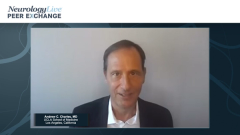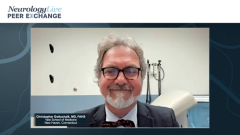
Preventative Migraine Therapies: The ADVANCE Trial and the Future
Jessica Ailani, MD, details how the phase 3 ADVANCE trial will shape the research of future agents for preventive migraine treatment.
Episodes in this series

Jessica Ailani, MD: These are important points. There are several measures looking at disability. We looked at 50%, 75%, and 100% reduction [in disability], also looking at the reduction of headache days. I don’t think it’s because this drug just decided to work. We’re seeing a learning pattern. This study looked at patients who were able to have up to 4 preventive treatments that had failed the patient. This was not done in earlier trials for migraine prevention.
They learned from the CGRP monoclonal trials, which had low placebo rates in patients who had experienced failure from other drugs. This is intelligent clinical trial designing. This is what we need to do. We need to learn from other trials and build upon them. The hope is that in the next trials that come around, we’re going to learn and keep building better trials. We all have so much to gain from this because then you get better drugs to patients, and they have better outcomes. Another example of this is when you look back to the CGRP monoclonal antibodies; eptinezumab came out later. It didn’t have a trial that looked at higher treatment failures, but they noticed that their IV [intravenous] infusion could start to work quickly. They designed a trial saying, “What if we infuse this drug? How soon could we see an effect?”
With galcanezumab and erenumab, they had done some studies looking back. They started to do calculations backward looking for the first day you could see an effect. Galcanezumab and eptinezumab had done backward math and said, “You could see an effect on day 1.” What if we proactively looked at the time effect you see after this infusion. They did a study looking at treating a migraine attack when it happens and how soon you see a response? They call this the RELIEF trial, and they measured that you could see a response at 4 hours. You could see the response occur at 2 hours. Imagine telling a patient who’s having a migraine that your preventive effect could start as soon as 2 hours and you’re protected for up to 3 months after.
When you have to have this conversation, as Rebecca was mentioning earlier, to a patient in clinic and you tell them here’s the migraine prevention, there are minimum adverse effects, you could start to see results within the first few hours, and those results can last a long time. And atogepant—they learned from that too, so they tried to measure back to how soon in the first few hours they can see a response. This is intelligent clinical trial designing. Let’s learn from one another and start to measure the first hour you could see a response because that’s what matters to the patient. They don’t have the patience to wait 3 months to see a response. They give up, and I don’t blame the patient. I don’t want to wait 3 months to feel better. That kind of trial design is meaningful. When we’re making specific medication that can quickly work, you want to see how fast I see onset. Rebecca, you wanted to comment.
Rebecca Erwin Wells, MD, MPH: These are all excellent points. One additional point is with these older agents. If you tried someone on an antiseizure medicine and it didn’t work, typically what I do is jump classes. Then I’ll try a blood pressure medication or 1 of the other options in a different class. One thing I’ve been surprised by in clinical practice is how patients can try 1 of the CGRPs, which might not work, but then try a different 1 that does work. Initially, when there were just injections available, I typically tried to switch from 1 targeting the receptor to 1 targeting the peptide.
As we’ve described, we’ve got the injections, we’ve got the infusion, and we’ve got the oral options. We have a lot of options. The oral options have been on the market for a little bit, so I haven’t been able to see clinically in practice how these compare with the injections. But I’ve been surprised and want to acknowledge the difference between older agents and CGRP: although all these options are targeting CGRP, they’re doing so in different ways. If somebody fails 1 option, there are still a lot of other options. As I said, I’ve been surprised at how somebody would try 1, get no benefit, and then all of a sudden there’s a miracle medication.
Jessica Ailani, MD: Very good point. Chris, you wanted to make a point?
Christopher Gottschalk, MD, FAHS: To reinforce something that you said, Jessica, about the evolution of our thinking and understanding about what migraine is as a disease and what treatments matter. For a long time we’ve been stuck with the notion that there are hard lines between preventive therapy and acute therapy, that you have things that will make headache attacks less likely or things that will help you when you need it. Lo and behold, we have a new class of therapies whose physiology we understand better, which say, “Wait a minute, you want to have not as many attacks that are not as severe or you have an attack that you want to be shorter and not as bad.” Is that different? Floor wax, dessert topping—doesn’t seem to matter. You can use a treatment that modifies migraine physiology, and it may work in different ways. That will inform our trial design and our thinking about what agents will matter in the future.
Jessica Ailani, MD: It’s pretty mind-blowing. In clinical practice, there are times I see a patient who has been on all these treatments, every monoclonal, and suddenly responds to preventive gepant. You sit there and you’re like, “Is this real? Is this not real?” Then I think back to the trial data. This person does not have placebo left. There’s no placebo response. It’s like I’m throwing sticky tack, and they know it. It’s random. They didn’t expect it, I didn’t expect it, and they don’t even want to tell you. You look at them and you’re like, “How are you doing?” They don’t want to say anything. That’s when you know. They just give you that blank stare, and I’m like, “Really? They’re like, “Shhh.” You’re like, “No way!” They’re like, “Shhh. I’ll see you in a few months. Just write me a refill.”
Rebecca Erwin Wells, MD, MPH: Like when you’re on call and haven’t gotten paged and you’re like, “Shhh, don’t say anything.”
Jessica Ailani, MD: Because then it’s like you’re sitting there in your office, and you’re like, “What’s going on?” This is what keeps us going. This is what keeps me thinking and writing project proposals and making my fellows read more and keeping them up at night. I just have to say thank you. This has been an outstanding section about novel treatments. I agree with Stephanie. We’ve learned so much about refractory migraine, which is what I’ve been teaching about. Is it’s refractory because we haven’t found the right targets for these patients, which is why we need to keep pushing science. We need newer targets because it doesn’t end with CGRP.
We need that next, and the next, and the next—migraine is like snowflakes. I love it. Each is different, so we need individualized and different targets for our patients, so we can keep the hope for them and we can have all these amazing options, so most of our patients have the response where they’re telling us to shush, but they have calendars that are mostly empty. I hope you guys will join us for our next segment, which is going to be about best practices in preventive migraine.
Jessica Ailani, MD: Thank you to our audience for watching this Neurology Live® Peer Exchange. I hope you’ve enjoyed watching this program as much as we’ve enjoyed spending this time together. If you’ve enjoyed this content, please subscribe to our e-newsletters to receive upcoming Peer Exchanges and other great content right in your in-box.
Transcript edited for clarity.
Newsletter
Keep your finger on the pulse of neurology—subscribe to NeurologyLive for expert interviews, new data, and breakthrough treatment updates.








